The Cycle of Habit and the Habit of Cycling
“Your beliefs become your thoughts,
Your thoughts become your words,
Your words become your actions,
Your actions become your habits,
Your habits become your values,
Your values become your destiny.”
― Mahatma Gandhi
I’m a habitual reader, bordering on addiction. I’ve always got (at least) one book going, and when I finish it I’m immediately looking for my next “fix.”
At the recommendation of my wife, Carol, I’m now reading The Power of Habit, by Charles Duhigg. It’s an engaging and enlightening investigation of how our habits are formed, how difficult it is to change them, and how we can create new ones.
My other major habit is, of course, cycling. My habits of reading and cycling began around the same time, and perhaps for the same reasons. My earliest memories of reading are tearing through the SRA Reading Lab cards, starting in first grade. First grade was also when I finally managed to get the training wheels off my bike and ride on two unfettered wheels. Both served my curiosity and desire for freedom and exploration. As a teen I’d sometimes carry a book on my summer break cycling explorations in rural northeast Ohio. I’d often stop in a park in some small town and read. Today I cannot imagine a life without either habit.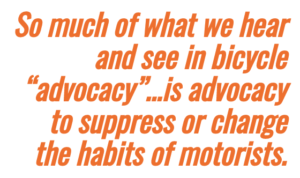
I’ve certainly thought of my cycling as a habit, but never in the clinical sense as explored in Duhigg’s book. Perhaps that’s why I’ve always bristled when asked by a non-cyclist acquaintance I haven’t seen for some time: “Are you still bicycling?” It sounds vaguely accusatory to me, like: “Are you still an alcoholic?” I’ve been so permanently hard-wired as a cyclist that it’s just like a chemical addiction.
Unlike most adult cyclists, I didn’t give up cycling when I got my driver’s license, then pick it up again some years later when looking for a way to “get back in shape.” I never had to “create a new habit” for cycling, so I may not be the best person to tell you how to do that. But building any new habit requires removing barriers to the new behavior, and then rewarding yourself when you do it.
Removing barriers could include putting your bike in the most convenient place to be used, buying a floor pump so it’s easy to keep your tires inflated or – best of all – being comfortable riding on the streets where you live and work, so you don’t feel like you have to load your bike onto your car and take it to a trail to ride.
And rewards? Well, that’s the easy part. Cycling burns calories, so you can reward yourself with your favorite food or drink.
“Nothing so needs reforming as other people’s habits.” – Mark Twain
What keeps so many of us from biking more is other peoples’ habits – particularly motorists. So much of what we hear and see in bicycle “advocacy” is really not advocacy of cycling at all; it’s advocacy to suppress or change the habits of motorists. As hard as it can be to change your own habits, it’s many times harder to change the habits of others. Especially when those others outnumber you 100-to-1. Motorists don’t necessarily improve their habits when a bike lane, sidewalk or sidepath is built, or when a new law is passed.
In order to change a habit you need a cue and a reward. Finger-pointing is counterproductive. Telling others “You have to change your habits for my sake” is a non-starter. Even if they did want to change, are they going to get enough opportunity and practice to learn a new habit?
For example, the most common crash between a motorist and bicyclist is when the motorist is pulling out from a driveway or side street preparing to turn right and the cyclist is coming down the sidewalk facing on-coming traffic. The average motorist might look just a few feet to the right where a pedestrian might be. But to see a cyclist approaching at 12 miles per hour, that driver will need to look at least 100 feet down the sidewalk to the right. They rarely do. In most areas the chance that such a driver will encounter an approaching cyclist is very small. A cyclist might come by once every fifteen minutes.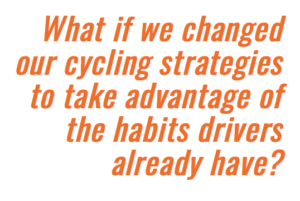
So even a motorist consciously trying to build a new habit is going to get little opportunity to practice. The cues are rare, and so are the rewards. The same can be said for all the other less-common types of conflicts.
Advocates like to tout the safety of cycling in The Netherlands, but may not realize that Dutch drivers have always had far, far more opportunity to build the habits of scanning for, yielding to, and safely passing cyclists. Long before the Dutch started building so many bikeways, it was common to see 10 to 15 percent bicycle traffic in their cities. That means one out of every seven to ten street users is a cyclist. Think of the habit-building opportunity in such an environment compared to the average American street, where cyclists are less than 1 percent.
Rather than tell millions of others to change their habits in an environment that discourages them from doing so, what if we changed our cycling strategies to take advantage of the habits drivers already have?
That’s what CyclingSavvy is: A set of strategies designed to take advantage of the habits American motorists have now. Our challenge at American Bicycling Education Association is to make successful cyclist safety strategies habitual for American cyclists. With a New Year around the corner, that will be – continues to be – our resolution.
What’s your resolution to make cycling a stronger habit for you and your friends? What cues and rewards will you use? Please share your comments below!

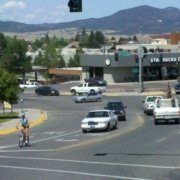
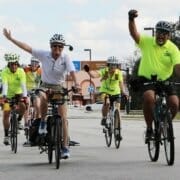
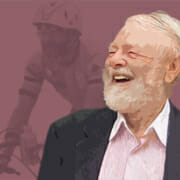

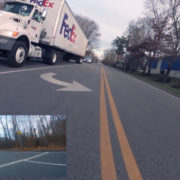
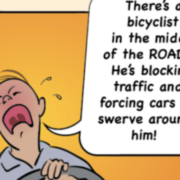
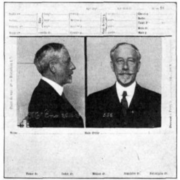
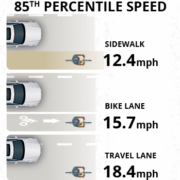
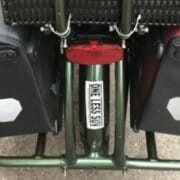



Very well written. There needs to be such a movement. LAB has forgotten this, apparently.
When first approaching anything, it is a natural reaction to want to induce change into the existing system. Of course, for safer bicycling that must mean curbing not only the addiction of your state’s DOT to catering to cars, but also reminding them, as a recipient of federal-aid, to start to take heed of the volumes of the inclusive mandates and laws passed to get more bicycles on the road, and that they should begin applying them at the project level…today. Watch a documentary on building the Panama Canal to see how hard this can be. Think like an advertiser. Recency and frequency. Or consider my “ants at a picnic” example. Ants are very organized and through sheer numbers they meet objectives and create change. They literally can move mountains. Educated bicycle drivers, lots of them, who understand how to move within the traffic system, biking often and proactively pursuing educating others, have the same opportunity as ants to induce organized, incremental change. In my home town, where we have a four-lane 40 MPH highway as our main street, if 50 people were responsibly driving their bikes daily, motorized traffic would start to adjust and our City Hall would take notice and so on. 2018 should be the the year of education and how to make it ongoing for motorized and non-motorized drivers alike.
What I’ve learned in my 20+ years in transportation planning focused on cycling and walking is that land use and demographics are key, and infrastructure is not nearly as important as we think. In Central Florida we’ve added over 500 miles of bike lanes and paved shoulders, and over 150 miles of paths over those 20 years and our bicycle commute rate hasn’t changed. A key element of land use is automotive parking supply and pricing. That is the greatest inducement for auto use. That’s the biggest reward for the auto habit. The Dutch and Danes have known this for years, too. They severely constrain car parking, which drives people to transit and cycling.
Brilliantly said.
Last night we celebrated our 104th Tuesday Night Ride in Saint Louis. Taking a cue from the folks who started the Plaza Midwood Tuesday Night Ride in Charlotte, NC, we started the Maryland Plaza Tuesday Night Ride on January 5, 2016, and haven’t missed a Tuesday since. It’s a remarkable event on many levels, and has created savvy cyclists who have yet to set foot in a CyclingSavvy workshop.
What impresses people most is how easy and uneventful our rides are. Even though we’re generally controlling our travel lanes, we rarely experience incivility. We try to make it easy for motorists to go around us, who return the favor by changing lanes to pass.
One night a few weeks back, Michael noted: “This is a great route, Karen!” Whoa! This was an amazing admission, as it came from a traffic-averse guy who had just ridden on Kingshighway, a huge multi-lane road in Saint Louis made “not scary” with savvy cycling principles.
We have a number of ride leaders now. It’s so gratifying to watch them use savvy cycling strategies, even when they’re not graduates of CyclingSavvy.
“We’re turning right into the LEFT lane,” ride leader Susan told us on another ride. I was tickled to hear her direct us with a strategy straight out of the CyclingSavvy playbook–just one of many that makes riding anywhere easy.
I can think of no better way to plant seeds for the habit of bicycling than to ride as a savvy cyclist, with other savvy cyclists, week after week. :-)
This is a great summary of CS it teaches you how to cycle in the world as it is not as it now and make the best out of things. Sure things aren’t perfect and both motorists and cyclists commit infractions. But instead of focusing on eliminating those infractions it teaches you to expect those infractions and operate around them in a way that they become non-issues.
Habits aren’t necessarily “infractions.” Our adherence to the normal rules of movement is also a habit.
Mighk, your post has so many fantastic dimensions. Thank you! I’ll focus on just one: finger wagging is not effective. So true! It’s very important to me to be joyful when I ride. It’s easy to do because I love to ride. But, whether I like it or not, I am an ambassador to cycling in my <1% bicycle mode-share city. How can I promote cycling when I'm dour and angry??? Whenever I talk to others about cycling I want to focus on the joy and safety of my transportation choice. Thanks to Cycling Savvy this is all true–no false advertising here! Mighk, you are a marvelous leader and role model and ABEA is lucky to have you!!
It was about 15 years ago that I started seeing really good stuff written by this guy who didn’t know how to spell “Mike.” The hits just keep on coming. Well done, Mr. Wilson.